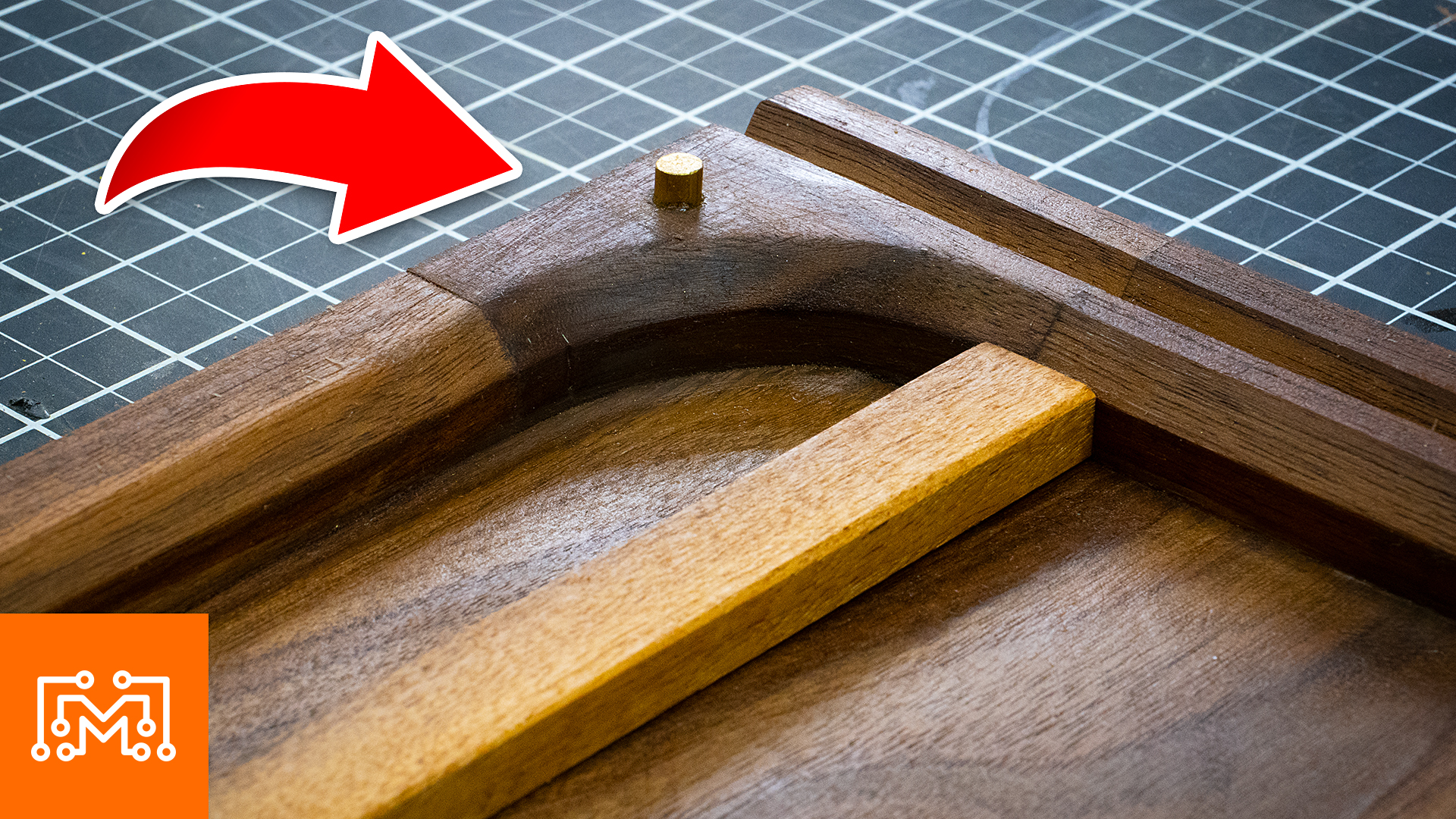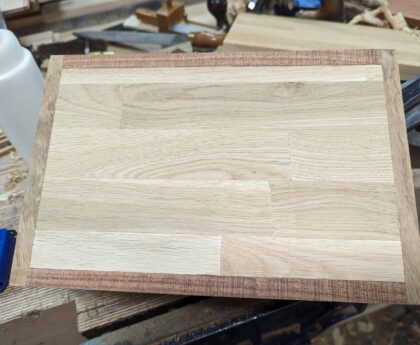Today, we’re going to try something a bit different. I’m going to build something out of wood, but here’s the twist – I’m not going to reveal what it is or what it’s for right away. As we walk through my building process, see if you can figure out what I might use it for. Let’s get into it.
The first super-traditional exotic woodworking material I’m going to use is one of my favorites—Kinda Wood. OK, it’s MDF (you know me). This piece is going to be the base of my project and everything is going to be attached to it. I cut it down on the table saw and then used a band saw to round out the corners. A little sanding and we have a base!
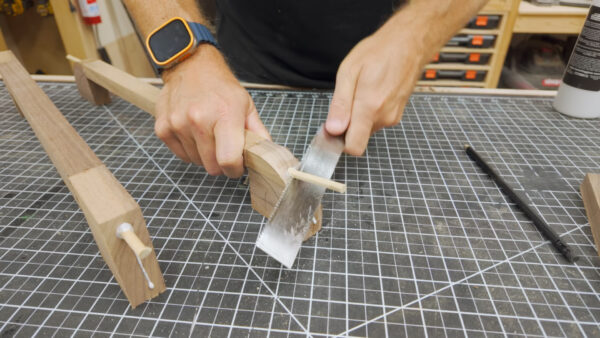 Next, I moved on to creating a frame using solid walnut scraps. The MDF base will sit inside of this walnut border. The rounded edges of the MDF base made it a little more challenging to get the border right, but it wasn’t too bad. I cut and joined the walnut border using dowels, then traced the profile of the MDF base into the walnut border and cut it with a bandsaw to match the base’s edges. With a little sanding and final assembly, I had a nice walnut border around the base. Any ideas on what this is yet?
Next, I moved on to creating a frame using solid walnut scraps. The MDF base will sit inside of this walnut border. The rounded edges of the MDF base made it a little more challenging to get the border right, but it wasn’t too bad. I cut and joined the walnut border using dowels, then traced the profile of the MDF base into the walnut border and cut it with a bandsaw to match the base’s edges. With a little sanding and final assembly, I had a nice walnut border around the base. Any ideas on what this is yet?
 The next exotic and traditional woodworking material is one of my favorite types of wood—STEEL! I want this steel sheet to be the same size as the MDF base, so similar to the walnut border process I traced out the profile on to the sheet. Then I was able to cut out the steel sheet with an angle grinder and the result was a steel sheet that was pretty close to the same size as the MDF base. It didn’t need to be perfect though, I just needed the steel on one side of the MDF. So I used some contact cement and that part was done! Any guesses?
The next exotic and traditional woodworking material is one of my favorite types of wood—STEEL! I want this steel sheet to be the same size as the MDF base, so similar to the walnut border process I traced out the profile on to the sheet. Then I was able to cut out the steel sheet with an angle grinder and the result was a steel sheet that was pretty close to the same size as the MDF base. It didn’t need to be perfect though, I just needed the steel on one side of the MDF. So I used some contact cement and that part was done! Any guesses?
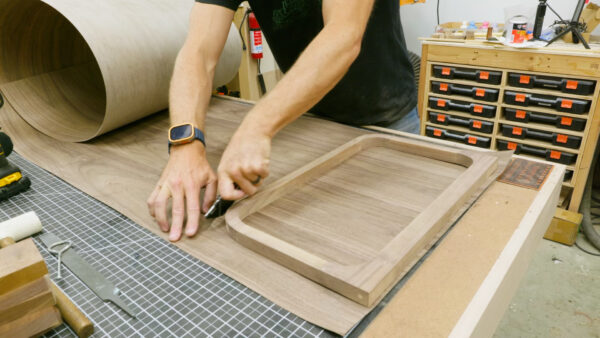 The next step involves…WOOD. Well, veneer which is really thin wood. I want the MDF to look more like solid wood (which is a common technique) so I used some walnut veneer to match the look of the border. I traced the profile of the base (again) and cut out two pieces of veneer. Then I used contact cement to add the veneer to both sides of the base. Now the whole assembly looks like a solid walnut pieces, and acts like one except for one major difference—it’s magnetic!
The next step involves…WOOD. Well, veneer which is really thin wood. I want the MDF to look more like solid wood (which is a common technique) so I used some walnut veneer to match the look of the border. I traced the profile of the base (again) and cut out two pieces of veneer. Then I used contact cement to add the veneer to both sides of the base. Now the whole assembly looks like a solid walnut pieces, and acts like one except for one major difference—it’s magnetic!
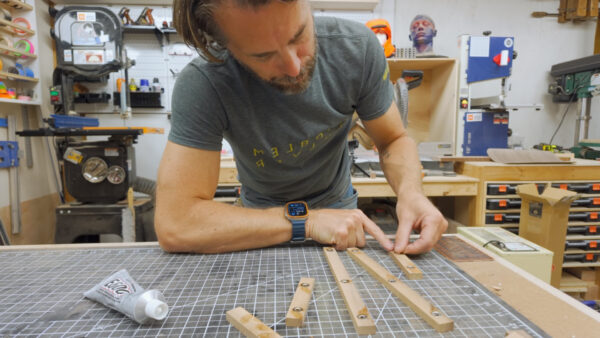 I cut small strips of walnut that fit within the main surface and embedded magnets within the underside of each. Now the whole surface has wooden dividers that can be placed anywhere, moved, adjusted, and will always stay affixed to the “wooden” surface of the base. It’s super handy for…reasons you’ll see soon.
I cut small strips of walnut that fit within the main surface and embedded magnets within the underside of each. Now the whole surface has wooden dividers that can be placed anywhere, moved, adjusted, and will always stay affixed to the “wooden” surface of the base. It’s super handy for…reasons you’ll see soon.
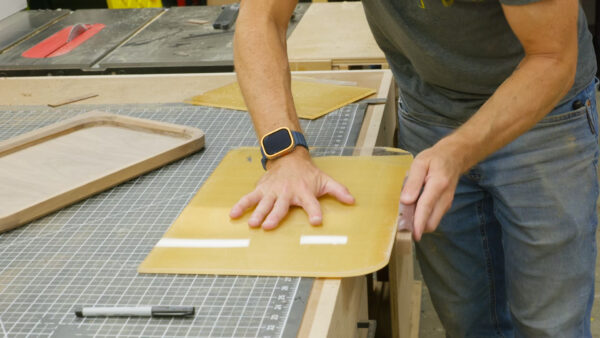 The final step might give it away. I used some clear wood (ok…acrylic) to trace the profile of the assembly (again) and cut it out on the bandsaw. I could have used a laser or a CNC router to do this, but since everything is done by hand here, tracing is a great way to get the exact shape that I need. I did eventually use the laser to engrave some details on the surface, but those were just cosmetic. I drilled some registration holes into the acrylic and then glued some short brass rods to the wooden surface so the acrylic can attach to the wooden surface as a cover. Then I used a router to cut a channel into one side of the whole board.
The final step might give it away. I used some clear wood (ok…acrylic) to trace the profile of the assembly (again) and cut it out on the bandsaw. I could have used a laser or a CNC router to do this, but since everything is done by hand here, tracing is a great way to get the exact shape that I need. I did eventually use the laser to engrave some details on the surface, but those were just cosmetic. I drilled some registration holes into the acrylic and then glued some short brass rods to the wooden surface so the acrylic can attach to the wooden surface as a cover. Then I used a router to cut a channel into one side of the whole board.
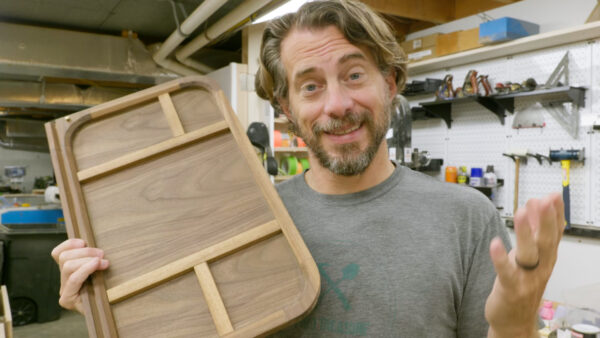 And it’s done! With some finish this thing really comes together. I love the look of walnut and brass together, and the acrylic is a great minimal top that still shows a lot of the wood and metal detail. So what is this thing? Many of you already know that building with LEGO is one of my favorite things to do. Always has been. At the end of a long day I love to sit down on the couch and build a lego set, but that often means hunching over a table to do it—and that gives me back pain. This walnut tray allows me to build lego in my lap in a more comfortable position!
And it’s done! With some finish this thing really comes together. I love the look of walnut and brass together, and the acrylic is a great minimal top that still shows a lot of the wood and metal detail. So what is this thing? Many of you already know that building with LEGO is one of my favorite things to do. Always has been. At the end of a long day I love to sit down on the couch and build a lego set, but that often means hunching over a table to do it—and that gives me back pain. This walnut tray allows me to build lego in my lap in a more comfortable position!
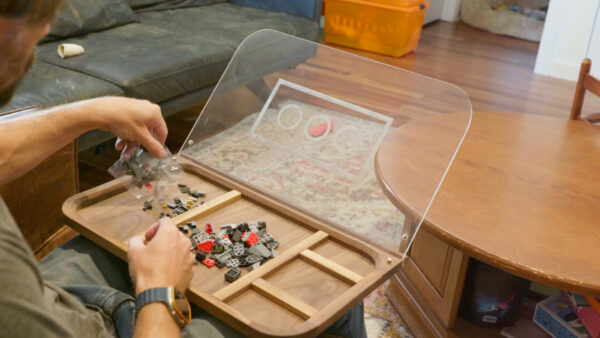 The dividers can be moved around as needed to separate different pieces I am working with. They stay in place really well but can be moved without issue as I go. The acrylic cover can be placed into the slot along one side to serve as a stand for instruction books. Then, when I’m done I can close it up and the dividers will keep all of my pieces separated without issue until the next time I need them. I love it!
The dividers can be moved around as needed to separate different pieces I am working with. They stay in place really well but can be moved without issue as I go. The acrylic cover can be placed into the slot along one side to serve as a stand for instruction books. Then, when I’m done I can close it up and the dividers will keep all of my pieces separated without issue until the next time I need them. I love it!
I hope this gives you ideas about things that you can make for yourself that solve a problem. Keep an eye out for things that you do throughout the day that might benefit from something like this. You could build something similar for yourself! It’s ok to use whatever materials you have on hand and it’s fun to customize it to your own needs! This one has been a fun one, and I look forward to using this LEGO build tray often. I hope you found something useful. Thanks for reading. Now go make awesome stuff!
